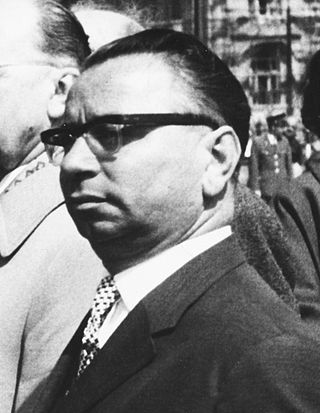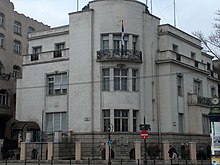
Imre Nagy was a Hungarian communist politician who served as Chairman of the Council of Ministers of the Hungarian People's Republic from 1953 to 1955. In 1956 Nagy became leader of the Hungarian Revolution of 1956 against the Soviet-backed government, for which he was sentenced to death and executed two years later. He was not related to previous agrarianist Prime Minister Ferenc Nagy.

The State Protection Authority was the secret police of the People's Republic of Hungary from 1945 to 1956. The ÁVH was conceived as an external appendage of the Soviet Union's KGB in Hungary responsible for supporting the ruling Hungarian Working People's Party and persecuting political criminals. The ÁVH gained a reputation for brutality during a series of purges but was gradually reined in under the government of Imre Nagy, a moderate reformer, after he was appointed Prime Minister of Hungary in 1953. The ÁVH was dissolved by Nagy's revolutionary government during the Hungarian Revolution of 1956 and succeeded by the Ministry of Internal Affairs III.

The Hungarian Revolution of 1956, also known as the Hungarian Uprising, was an attempted countrywide revolution against the government of the Hungarian People's Republic (1949–1989) and the policies caused by the government's subordination to the Soviet Union (USSR). The uprising lasted 12 days before being crushed by Soviet tanks and troops on 4 November 1956. Thousands were killed and wounded and nearly a quarter of a million Hungarians fled the country.

János József Kádár, born János József Czermanik, was a Hungarian Communist leader and the General Secretary of the Hungarian Socialist Workers' Party, a position he held for 32 years. Declining health led to his retirement in 1988, and he died in 1989 after being hospitalized for pneumonia.

Gyula Kállai was a Hungarian communist politician who served as Minister of Foreign Affairs from 1949 to 1951, Chairman of the Council of Ministers from 1965 to 1967 and Speaker of the National Assembly from 1967 to 1971. He was also President of the National Council of the Patriotic People's Front from 1957 to 1989.

Ferenc Nagy was a Hungarian politician of the Smallholders Party who served as Prime Minister of Hungary from 1946 until his forced resignation in 1947. He was also a Speaker of the National Assembly of Hungary and a member of the High National Council from 1945 to 1946. Nagy was the second democratically elected prime minister of Hungary, and would be the last until 1990 not to be a Communist or fellow traveler. The subsequent Hungarian prime minister Imre Nagy was unrelated to him.

The Hungarian People's Republic was a one-party socialist state from 20 August 1949 to 23 October 1989. It was governed by the Hungarian Socialist Workers' Party, which was under the influence of the Soviet Union. Pursuant to the 1944 Moscow Conference, Winston Churchill and Joseph Stalin had agreed that after the war Hungary was to be included in the Soviet sphere of influence. The HPR remained in existence until 1989, when opposition forces brought the end of communism in Hungary.
Goulash Communism, also known as refrigerator communism, Kádárism or the Hungarian Thaw, is the variety of state socialism in the Hungarian People's Republic following the Hungarian Revolution of 1956. During János Kádár's period of leadership, the Hungarian People's Republic implemented policies with the goal to create a high standard of living for the people of Hungary coupled with economic reforms. These reforms fostered a sense of well-being and relative cultural freedom in Hungary, giving it the reputation of being "the happiest barracks" of the Eastern Bloc during the 1960s to the 1970s. With elements of regulated market economics as well as an improved human rights record, it represented a quiet reform and deviation from the Stalinist principles applied to Hungary in the previous decade.

Géza Losonczy was a Hungarian journalist and politician. He was associated with the reformist faction of the Hungarian communist party.

Hungarian–Soviet relations developed in three phases. After a short period when Béla Kun ruled a Soviet Republic, the Horthy era saw an almost complete break in relations until after World War II. The Yalta Conference, however, created conditions that ensured political, economic, and cultural interventions by the Soviet Union in internal Hungarian politics for the 45 years of the Cold War. Hungary became a member of the Warsaw Pact in 1955; since the end of World War II, Soviet troops were stationed in the country, intervening at the time of the Hungarian Revolution of 1956. Starting in March 1990, the Soviet Army began leaving Hungary, with the last troops being withdrawn on June 19, 1991.

Erzsébet Nagy was a Hungarian writer and translator, and the only child of the former Prime Minister of Hungary, Imre Nagy, who was executed following the failed Hungarian Revolution of 1956.

Hungary–Russia relations are the bilateral foreign relations between the two countries, Hungary and Russia. Hungary has an embassy in Moscow and two consulate-generals. Russia has an embassy in Budapest and a consulate-general in Debrecen. Both countries are full members of the Organization for Security and Co-operation in Europe.

Relations between Hungary and Serbia, or Serbo-Hungarian relations form a part of the wider politics of Central and Southeast Europe. The two countries have a long relationship stretching back to the Middle Ages. History of official diplomatic relations of Hungary and Serbia dates back to 21 November 1882, when they were established between the Kingdom of Serbia and Austria-Hungary. Today, Hungary has an embassy in Belgrade and a general consulate in Subotica, while Serbia has an embassy in Budapest and an honorary consulate in Szeged.

Hungary–North Korea relations (Korean: 마쟈르-조선민주주의인민공화국 관계) are foreign relations between Hungary and Democratic People's Republic of Korea (DPRK), commonly known as North Korea. Relations between the two countries existed since the Korean War, but relations have been poor since 1988.
Edward Thompson Wailes was an American diplomat and lawyer who served as an ambassador to Czechoslovakia, South Africa, Iran, and Hungary. He also served as the sixth Assistant Secretary of State for Administration.

New Public Cemetery is the largest cemetery in Budapest and one of the largest in Europe with an area of about 2.07 km2 and 3 million burials since its opening in 1886. It is adjacent to the Kozma Street Cemetery; the largest Jewish cemetery in Hungary. Its main building, which was constructed in 1903, has a 26-meter-high bell tower. In addition to its rich vegetation and wide avenues, the cemetery is famous for plot 301, where the martyrs of the 1956 revolution were buried. Today, an enormous modern monument by György Jovánovics marks their graves.
Miklós Vásárhelyi was a Hungarian journalist and politician from Hungary. He was the press secretary in the government of Imre Nagy during the Hungarian Revolution of 1956. After Hungary’s democratic transition in 1990, he became a member of the National Assembly.
Imre Nagy first became Chairman of the Council of Ministers of the Hungarian People's Republic on 4 July 1953 upon the resignation of Mátyás Rákosi, forming a government more moderate than that of his predecessor which attempted to reform the system. However, Rákosi remained First Secretary of the ruling Hungarian Working People's Party, and he was ultimately able to use his influence to force Nagy out of office in April 1955.

Hungary–Yugoslavia relations were historical foreign relations between neighboring Hungary and now broken up Yugoslavia.
Sándor Haraszti was a Hungarian journalist and politician.


















